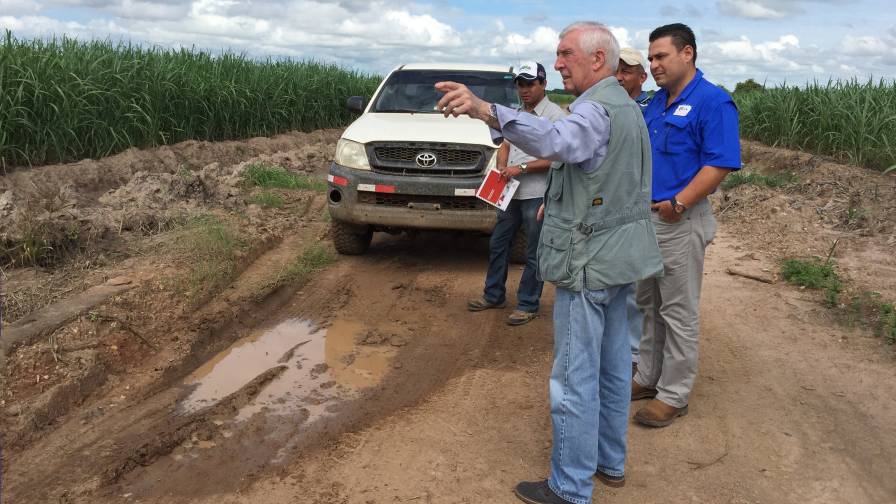Additives and Enhancers: Getting the Most from Your Fertilizer
Opportunities. Awareness. Growth … the Wild, Wild, West. Those are just a few of the descriptions manufacturers use to describe the additives and enhancers market.
“The market for additives and soil enhancers has been steadily growing,” Brian Haschemeyer, Vice President of Discovery & Innovation, BRANDT. “These types of products are designed to complement traditional fertilizers by improving soil health, increasing nutrient uptake, improving stress tolerance, and enhancing crop growth. Some of the most used additives and enhancers include nitrogen stabilizers, micronutrient blends, and biostimulants such as, microbials, seaweed extracts, humic and fulvic acids.”
Josh Griffin, Product Marketing Manager, Verdesian Life Sciences, says his company has seen a similar scenario. “Overall awareness of the additive and enhance market has significantly increased over the past several years,” he says. “With an increased appetite from growers to split nitrogen applications, nitrogen loss still remains top of mind in order to receive the highest ROI possible.”
The growth is expected to continue.
“We think the current market for additives and enhancers is showing a lot of opportunity for growth,” says Ben Hilgers, Marketing Manager, Plant Nutrition, WinField United. “Given the volatility of nitrogen pricing, a continual eye on potential EPA/governmental restrictions and continuous push for higher yields, additives should be a compelling buy for both retail and growers. There still is a lot of untreated fertilizer and the frontier continues to be the untreated acre per ton.”
Of course, with any growing business there are a lot of people interested in entering that space. And that creates an atmosphere akin to the “Wild, Wild West … more $8 per acre products with outrageous claims,” says John Kugler, Co-President, Kugler Co. “Few have any real benefit. More than likely (they) will cause mixing problems with fertilizer carriers.
Sold on ratio, sold as replacements … minute amounts of active ingredients that are expected to work as well as 10 pounds or N or P or micros…buyer beware.
“There are some new labeling requirements that are coming out to try and make sense of classification of these products … which is needed,” Kugler continues.
The market segment is expected to see continued growth.
“Numerous market outlook analysts agree that the ag segment of the fertilizer additive space, currently valued at or around $3 billion is on track to grow by about 4% annually and is projected to reach $4 billion by 2030,” says Christie Apple, Regional Sales Manager from the Great Lakes region, Timac Agro USA. “If we really take a closer look at why this continual growth keeps building, it’s plain to see that the dilemma of meeting the increasing world demands for protein and grains and the need to provide climate-smart solutions for the applied nutrients needs are a combined driving force.”
Understanding the science behind these products is critical to growth of the additives and enhancers market segment growth.
“Nitrogen stabilizers and phosphorus fertilizer enhancers were the first generation of products in this segment with a few dominant technologies and manufacturers,” says Dr. Jason Haegele, Agronomy Lead, NA, ICL Group. “The present and future of fertilizer additives and enhancers will be built on growth in the biologicals and biostimulants markets along with other novel approaches like nanotechnology. For example, there are already a wide range of microbial and biostimulant products purported to enhance the availability of nutrients, both those applied as fertilizer as well as nutrients locked in the soil.”
These products offer end-users a variety of benefits. But like any product it comes down to profit.
“Koch Agronomic Services (KAS) is optimistic about the future of both enhancers, such as enhanced efficiency fertilizers, and additives such as micronutrients or seed-applied nutritionals,” says Eric Vogel, Product Marketing Manager. “As growers look to not only improve their nutrient use efficiency but also maximize their return on investment, we anticipate continued growth for these technologies.”
Emerging Markets
AZOMITE Mineral Products was founded in Utah in the 1940s. The company’s products are available on every continent except Antarctica. And the company has seen an increase in business in many areas.
Damon Fodge, Vice President of Sales and Marketing of DF International, AZOMITE distributor to Asia, has seen an uptick in organic fertilizer producers incorporating AZOMITE as an ingredient to their own soil product formulations and blends.
“These are often output as compost-based granules for ease in application and are a cost-effective means for getting our products distributed through very large areas such as Malaysia,” Fodge says.

J Paul Massam of AZOMITE Mineral Products says there are no geographic boundaries where AZOMITE can supplement soil programs and enhance soil fertility.
Dr. J Paul Massam and Vickie Massam of Massam LLC, AZOMITE distributors for Canada, Mexico, Central and Latin America, and the Caribbean have seen similar results.
“There are no geographic boundaries around opportunities where AZOMITE can supplement soil programs that enhance soil fertility, which supports plant yields, quality, and stress resistance,” J Paul says.
Vickie Massam added: “As growers around the world experience shifts in normal weather patterns, studies have shown that the natural elements in AZOMITE may help improve plant resilience. Who doesn’t need that?”
BRANDT has also seen interest around the globe.
“The demand for additives and enhancers is driven by a variety of factors, including regional crop needs, consumer demand, and environment,” Haschemeyer says. “For example, in North and South America, there is a strong focus on maximizing yields of key crops such as corn and soybeans. In Asia, the demand comes from improving soil health and increasing nutrient uptake in the crops.”
Timac Agro sees enormous potential in Asia. “No surprise here, but both China and India are two massive agricultural economies on exponential growth trends with no end in sight,” Timac Agro’s Apple says. “Because they are in the midst of such rapid expansion of ag tech, they have a voracious appetite for tools and resources that will help them develop best practices with peak efficiencies.”
Even areas that have mature ag markets have room for growth.
“I believe we will continue to see rapid adoption of nutrient additives and enhancers in regions of the world like Europe and Canada where current or proposed regulations will limit various aspects of fertilizer nutrient use,” says ICL’s Haegele. “Nutrient use efficiency achieved by the use of additives and enhancers will be an obvious target to maintain productivity with more limited inputs. Ultimately, a combination of regulations and increasingly common sustainability initiatives will shape this market.”
Additives and Enhancers Market Drivers
“One of the primary drivers of this change, is the increasing demand for higher yields and improved crop nutrient use efficiency,” says Brandt’s Haschemeyer. “The biological segment of this market is the fastest growing sector. Overall, the market has become more diverse and dynamic.”
Yield isn’t the only factor.
“The biggest influence or change last few years has been nitrogen prices,” Winfield’s Hilger says. “Providing a solution to be more efficient with that fertilizer spend is and will continue to be more important in the future.”
The Role of the Retailer
“There is a fertilizer additive or enhancer appropriate for every acre,” Haegele says. “Retailers have a responsibility to help their farmer customers understand which options in the market make the most sense for the local environment, soil types, and cropping system. This requires a commitment to continued employee education and training on agronomy and farm-gate economics, as well as willingness to proactively partner with manufacturers to trial products in the local environment.”
Understanding is always critical.
“Retailers can help advance this market by continuing to educate growers on best management practices and solutions that align with the 4R Nutrient Stewardship framework,” Koch’s Vogel says. “Effectively managing nutrient inputs to make the most out of a grower’s investment is always a preferred strategy, but even more so recently.”
Timac Agro’s Apple agrees.
“Ag retailers are the gatekeepers to the adoption of a nutrient stabilizer,” Apple says. “Agronomists are a person-of-influence in the farm input decision process. They are a resource of information on the latest ag management practices, and also a source of products to fulfill recommendations. If they know the farm operation and the challenges that farmer faces, they will be able to trace some of these challenges back to nutrient use efficiency, which creates the perfect opportunity to discuss which form of nutrient stabilizing would be warranted and to achieve maximum impact on NUE.
An informed and confident Ag Retail will be the best steward of these technologies.”
It’s not just the growers that need to believe in these products.
“Retail sales representatives and agronomist that believe in the products they sell will have the most success in moving these products as they are still the most trusted source for farmers,” Kugler says.
“Retailers have seen this market pay time and time again. Ultimately the retailers own the relationship with their growers,” says Verdesian’s Griffin. “If a retailer doesn’t believe in this market, how can we expect growers to believe in this market? I believe that retailers bringing the facts and the data to their growers and having conversations around this market segment is vital to its advancement moving forward.”
For WinField, it’s an industry-wide effort.
“We try to engage with our owners and retail sellers to best represent the agronomics behind this product category,” Winfield’s Hilgers says. “We partner with our vendors, be that Corteva, Koch, Verdesian or others to make sure we’re representing the science and agronomics behind additives.”
Looking to the Future
“The market is expected to see continued growth in precision agriculture technologies, which will enable farmers to apply additives and enhancers with greater accuracy and efficiency,” Haschemeyer says. “Another trend that is likely to shape the market in the coming years is the increasing use of data analytics. By analyzing data on soil health, weather patterns, and other factors, farmers will be able to tailor additive technologies to their fertilizer programs to the specific needs of their crops, further increasing their efficiency and reducing waste.”
Technology is critical to the growth of the segment.
“The fertilizer industry is under a lot of pressure to innovate right now to create sustainable solutions that not only protect the environment, but also improve grower ROI when fertilizer prices are high or volatile due to unpredictable world conflicts,” ICL’s Haegele says. “Not much has changed about the importance of NPK and other nutrients, but fertilizer formulation technologies and new developments in additives and enhancers will cause this segment to expand considerably.”
And with all the positives surrounding additives and enhancers there’s little wonder why providers are optimistic.
“I see the outlook bright for this part of the market,” Kugler says. “This is where the advancement for yield improvement and plant health will come from. NPK products are always the standards … but changes in tillage, amendments, foliar feeding, and irrigation will push the yields up. This is important … because the U.S. feeds the world.”
Even in mature markets there is room for growth.
“Considering that here in the U.S. market we are only leveraging these stabilizer tools on about 3% to 4% of all commercial nitrogen sold, a strong opportunity presents itself,” says Timac Agro’s Apple. “Taking into consideration new supply/demand norms, the environmental stewardship and related regulations farmers are now facing, along with managing a bottom-line impact for the farmer, we expect this market to not only retain its agronomic value, but to also become increasingly more mainstream in adoption. Retailers will have to manage their fertilizer allocations more efficiently as the world markets become more impactful. Likewise, farmers will need to extract more efficiency out of their nutrients purchased and applied. The fertilizer additive market is rife with tools and products to do that and are positioned to broaden that reach.”
Opportunities
“There are several key opportunities for growing the market which include advancements in technologies and emerging markets,” Haschemeyer says. “Overall, companies that can offer additives and enhancers, as well as those that can provide technology into them and tap into emerging markets, are likely to be well positioned for the growing market in the coming years.
“BRANDT has taken advantage of this market by acquiring companies like Talc USA,” he continues. “This relationship allows BRANDT a reliable delivery tool to get enhancer right in seed bed. Precision placement is often key to additive technologies. BRANDT and Talc USA offerings include micronutrients, enzymes, and inoculants to improve nutrient use efficiency, improve resistance to stress and early plant vigor.”
According to ICL’s Haegele, “Current-ly, most additives and enhancers are stand-alone products to be combined with fertilizers by the retailer or grower. This sometimes makes product use inconvenient or left to choice. I believe one of the biggest growth opportunities will be traditional fertilizer sources that have additives or enhancers incorporated into the fertilizer granule, liquid blend, or water-soluble formulation at the point of manufacturing.”
These products can even have an impact on a topic pervading many ag conversations recently — carbon.
“Most of our slow-release nitrogen-based products have a strong carbon base,” Kugler explains. “We have ideas on how to increase that for those that are carbon sensitive. Been eyeing a foliar phosphate for a few years and have a product that will be test marketed this year. Lots of pushback back on foliar phosphate from the academic side of ag. Some data points of tissue up take … so we keep working on it.”
New and innovative will continue to advance the market.
“The biggest opportunity we see for the additive and enhancer market is to continue innovating solutions that provide the most value to growers and their operation,” explains Koch’s Vogel. “Our goal is to provide efficient strategies and solutions for growers to better maximize their nutrient investments while also aligning with the 4R Nutrient Stewardship framework.”
And it always comes down to value.
“The biggest opportunity for growing the additives/enhancers market is helping growers continue to improve their bottom line, while being the best steward of their land that they can possible be,” says Verdesian’s Griffin. “A healthy bottom line plus positive land stewardship equals success.”
Challenges
“There are several key challenges such as, education on these products, regulatory hurdles, cost, and competitive landscape,” BRANDT’s Haschemeyer says. “Addressing these challenges will be critical to realizing the full potential of this market.”
As the market grows, so does the complexity.
“One challenge is simply having access to a multi-disciplinary team that understands all aspects of agronomy, marketing, mining of mineral nutrient sources, and fertilizer formulation and production,” ICL’s Haegele says. “Fortunately, as a global leader in the production of potash, triple super phosphate, polyhalite, water soluble fertilizers, and biostimulants, backed by a worldwide network of agronomists and commercial teams, ICL is well positioned to excel in this arena.”
With all the new products entering the market, end users to need to pay attention to what they’re buying.
“The watch-out has to be distraction from other ‘shiny objects,’” says WinField’s Hilgers. “There are a lot of entrants and big money being spent when it comes to biological n-fixing type products. Some of these we’ve seen some good promise, while others given the data we’ve seen while testing may be overstating their effectiveness. We need to shout about and educate people that there is tried and tested technology out there that can help get the most efficient use out of your fertilizer spend — fertilizer additives / stabilizers.”
And, of course, there’s still the old fear to get past.
“One of the biggest challenges this market has is overcoming the stereotype of ‘I tried those products once, and it didn’t work.’ The mindset shift from utilizing a product as a ‘one and done’ to a ‘program approach’ is needed not only in this segment, but our industry as a whole,” says Verdesian’s Griffin.






